~updated on August 12, 2017.
What could be easier than mixing a bit of powder in water, right? If it were only that simple…
When it comes to mixing milk replacer and feeding it to calves there are a surprising number of issues that can creep up, either from a mixing, feeding or an animal performance standpoint. How we measure milk replacer powder, how we mix it with water and the temperature at mixing and feeding time affect both the milk replacer and the calf.
Measuring Milk Replacer
Scoop
A complementary measuring scoop is usually provided in each bag of milk replacer — considered by many calf raisers to be an inconvenience that has to be fished out and thrown away. When used according to label instructions, the scoop can approximate the weight of the desired amount of powder. Basically, we’re using a volume estimate to approximate (or estimate) a weight measurement.
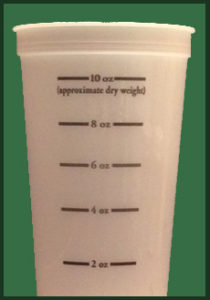 If you choose to use the scoop for this purpose, keep in mind that product density (how much actually fits in a scoop) varies from product to product and even within a product over time. So it’s a good idea to check the actually weight with a scale, and mark a line on the cup for the desired weight. Some scoops are pre-marked, but you still need to check the accuracy. Be consistent with how you scoop, and since manufacturers use different scoops, be sure to use the scoop that came with the product.
If you choose to use the scoop for this purpose, keep in mind that product density (how much actually fits in a scoop) varies from product to product and even within a product over time. So it’s a good idea to check the actually weight with a scale, and mark a line on the cup for the desired weight. Some scoops are pre-marked, but you still need to check the accuracy. Be consistent with how you scoop, and since manufacturers use different scoops, be sure to use the scoop that came with the product.
Weigh scale
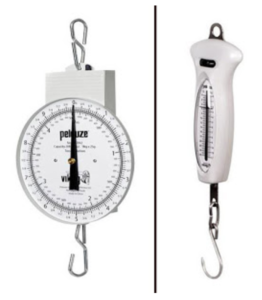 This is the best way to go. No doubt about it. Using a weighing device to measure weight eliminates the guesswork involved in using a scoop and assures consistency and accuracy. It minimizes variability from calf to calf, from batch to batch and from day to day. Variability is an even bigger challenge when more than one person is doing the measuring and mixing. Weighing milk replacer instead of relying on a scoop goes a long way toward keeping things consistent and running smoothly.
This is the best way to go. No doubt about it. Using a weighing device to measure weight eliminates the guesswork involved in using a scoop and assures consistency and accuracy. It minimizes variability from calf to calf, from batch to batch and from day to day. Variability is an even bigger challenge when more than one person is doing the measuring and mixing. Weighing milk replacer instead of relying on a scoop goes a long way toward keeping things consistent and running smoothly.
Kitchen/Household measuring cup
Although rarely an issue with seasoned calf raisers, I do come across folks from time to time who are using a standard measuring cup to measure milk replacer, usually with poor results. Perhaps there wasn’t a scoop in the bag, or maybe they simply wanted to improve their feeding accuracy, but their animals aren’t doing very well and they don’t know why.
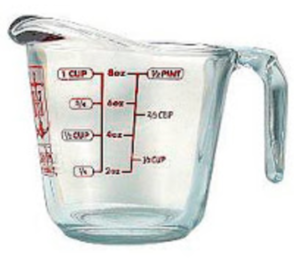 The problem stems from the ease with which we use a measuring cup to measure both dry and liquid ingredients. For example, 8 oz of water equals one cup. This is a volume measure, From a volume standpoint, a cup of water measures the same as a cup of rice, a cup of spinach or a cup of milk replacer powder. But they all have different weights. By using the 8 oz mark on the measuring cup to measure milk replacer powder, you’ll end up with about 1/2 the correct amount of powder.
The problem stems from the ease with which we use a measuring cup to measure both dry and liquid ingredients. For example, 8 oz of water equals one cup. This is a volume measure, From a volume standpoint, a cup of water measures the same as a cup of rice, a cup of spinach or a cup of milk replacer powder. But they all have different weights. By using the 8 oz mark on the measuring cup to measure milk replacer powder, you’ll end up with about 1/2 the correct amount of powder.
A large plastic 2 or 4 cup capacity measuring cup is nice for scooping powder into a bucket for weighing, but to use it for measuring, you need to calibrate it first by weighing the powder and marking the scoop accordingly.
Mixing Milk Replacer
Most milk replacers come with simple, easy instructions that tell you to add a certain amount of powder (usually 8 or 10 oz) to 2 quarts of warm water, mix, and then feed the mixture to the calf. That’s OK if you’re feeding the calf with a pail, but what if you want to fit that mixture into a 2 quart bottle or you’re mixing for more than one calf?
You soon realize you have a problem. When you add milk replacer powder to water, the powder displaces some of the water, resulting in more liquid than the original volume of water. When adding 8 ounces of powder to 2 quarts of water, the final volume is about 70 ounces instead of the 64 ounces (2 quarts) you started with. This solution is very different from one where you mix powder and water so that the final volume (not the starting volume) is 2 quarts — in this case you start with a quart or so of water, add powder, mix, then add more water until you reach a total volume of 2 quarts.
Solids
When using 8 ounces of powder, the concentration, or percent solids of each of these solutions is markedly different. When you add the powder to 2 quarts of water, the solution is more dilute and has about 10.7% solids. In the second case, where you add powder and water to a fixed final volume of 2 quarts, the solution has about 11.6% solids. Both solutions have less solids than whole milk which is around 12 – 12.5% solids.
Adding 10 ounces of powder to 2 quarts of water results in a solution that’s 13% solids. Adding the 10 ounces of powder and water to a final volume of 2 quarts gives you a solution that’s 14.5% solids.
To assure that calves don’t get short-changed nutritionally when feeding 8 ounces, mix powder and water to a final volume of 2 quarts. When feeding 10 oz of powder, add the powder to 2 quarts of water for 13% solids.
You can feed higher solids, but as solids percentage increases above 13%, access to free choice water becomes more important. Calves need additional water to help reduce the likelihood of scours or other digestive problems. The upper limit is about 18% solids.
The solids calculations used in the above examples are provided at the bottom of this article.
Mixing equipment
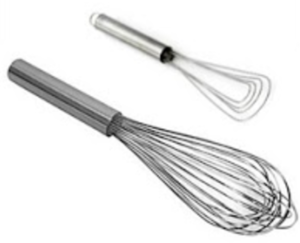 When mixing by hand, a wire whisk or whip should be used to help ensure complete mixing. Whisks are specifically designed for this function and are available in a variety of sizes. I recently came across a whisk that was 36 inches long.
When mixing by hand, a wire whisk or whip should be used to help ensure complete mixing. Whisks are specifically designed for this function and are available in a variety of sizes. I recently came across a whisk that was 36 inches long.
Some farms add a little power to the mixing processes by using a hand-held variable speed drill with a paint mixer attached. This can work OK, especially when mixing in 5 gallon buckets. But for the young and inexperienced, this type of unprotected technology has the potential for causing serious injuries.
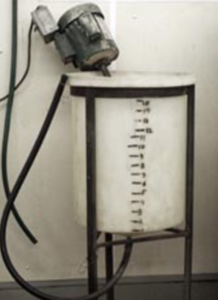 Power mixers are a good choice when mixing larger batches of milk replacer. Mixers can be stationary or portable and the tubs are typically made of plastic or stainless steel. The stationary mixer pictured here has a slightly translucent plastic tub that lets you see the level of liquid from outside the tub. This one has been calibrated and marked so it’s easy to tell just how much liquid you have. When mixing, gradually adding milk replacer powder to the mixer while it is running helps avoid lumps. Be sure to add all of the powder before you reach the final liquid volume.
Power mixers are a good choice when mixing larger batches of milk replacer. Mixers can be stationary or portable and the tubs are typically made of plastic or stainless steel. The stationary mixer pictured here has a slightly translucent plastic tub that lets you see the level of liquid from outside the tub. This one has been calibrated and marked so it’s easy to tell just how much liquid you have. When mixing, gradually adding milk replacer powder to the mixer while it is running helps avoid lumps. Be sure to add all of the powder before you reach the final liquid volume.
Solubility
Solubility is the greatest amount of milk replacer powder that will dissolve in a given amount of water at a specific temperature. Most milk replacer ingredients dissolve in water. However, there are ingredients and specialty additives that are less soluble and some that won’t dissolve no matter how much you mix. Most of these are suspendable in solution, and some may eventually settle to the bottom or rise over time. It is important to mix well so that all ingredients are evenly dispersed in the liquid. This ensures that each calf receives the appropriate combination and level of nutrients.
Temperature
Mix Temperature
The mix temperature is an important aspect of mixing milk replacer. I have seen mixing temperature recommendations from a low of 105° F (41° C) to a high of over 170° F (76° C). That’s a mighty wide range, and reflects a number of objectives.
For many calf raisers, it’s all about getting milk replacer powder into solution. A product that readily mixes in cool water may seem desirable, but it’s actually a bit irrelevant. Use of special emulsifiers during manufacturing can help suspend fat in cool liquid, but warm water is needed to bring the fat into full contact with the liquid. The typical fats used in milk replacers usually melt between 95° and 115° F (35°- 46° C). Once melted, the fat becomes an integral part of the liquid emulsion, interacting with proteins which help emulsify and dissolve the fat in the solution. At minimum, the water temperature used for mixing should be high enough to get this done. Using a lower mix temperature often leads to reduced solubility and may adversely affect ingredient digestibility.
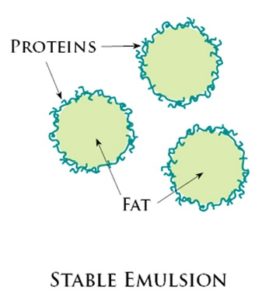 Fat Emulsion
Fat Emulsion
During manufacturing, mixing protein and fats in a solution has some interesting effects. Proteins interact with fats at their surface, binding with both the fat droplet and the surrounding water molecules. As the mix temperature is increased during manufacturing, the effect on fat is to break larger droplets into smaller ones. This increases the overall fat surface available for protein attachment which improves overall solubility and enhances fat digestibility.
In this way proteins coat the fat droplet, providing a barrier that prevents individual droplets from joining together and separating from the solution. The end result is a stable emulsion of fat and protein – referred to as protein encapsulated fat.
Emulsion Breakdown
Undesirable effects can occur if the temperature of the solution get too high during manufacturing or mixing on the farm. Excessively high mix temperatures can actually cause proteins to migrate away from the fat droplets. When this happens, fat droplets join together and rise to the surface of the solution. You may notice a slick deposit on mixing and feeding equipment when this happens. Another possibility is that proteins may remain attached to fat droplets, but aggregate together in high temperature conditions, causing clumping of protein/fat globules. Both situations are demonstrated in the image below. To avoid these problems, it’s best to keep mix temperature on the farm below 1450 F.
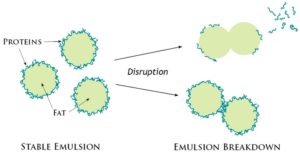
In reality, these behaviors are not just due to changes in temperature. High pressure during manufacturing helps break fat into smaller droplets. The types of proteins present, emulsifying agents, ion concentrations, pH, the presence of other ingredients and factors all affect the stability and effectiveness of the emulsion.
There are several different manufacturing processes for milk replacer. Each has its own powder characteristics and mixing requirements. This may sound too easy, but follow the manufacturers instructions regarding the mix temperature for their milk replacer to minimize the chance of any mixing issues.
Feeding Temperature
Temperature recommendations for feeding milk replacer range from about 102° – 107° F (38.9° – 41.7° C) in the US. Higher feeding temperatures may be recommended in other regions. Keep in mind that the normal body temperature of a healthy calf is just under 102° F . Feeding colder milk replacer means the calf will warm the milk replacer to its body temperature after it has been consumed. Not only does this waste energy, colder temperature liquids may reduce the calf”s willingness to drink.
Feeding warm milk replacer can help stimulate closure of the esophageal groove. This is important as it prevents milk replacer from entering the rumen and potentially causing digestive disturbances. This temperature effect appears to be fairly strong, since feeding warm water alone has been shown to stimulate esophageal groove closure when fed to calves up to 16 weeks old*.
For milk replacer to arrive at the calf at the right temperature, both the mixing temperature and your feeding procedures need to be considered. The temperature may need to be adjusted during mixing to accommodate the cooling that occurs between mixing and feeding time. This is especially important during cold weather. You may need to modify your feeding procedure to prevent excessive cooling.
Thermometer/Temperature Gauges
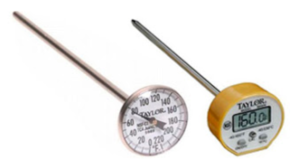 The only way to know the temperature is to measure it. Instant-read thermometers are very quick and inexpensive. You could use an in-line temperature gauge to determine your water temperature, but a thermometer is still needed to measure the temperature of the final mix. Cold milk replacer and mixing equipment can drop the mix temperature quite a bit.
The only way to know the temperature is to measure it. Instant-read thermometers are very quick and inexpensive. You could use an in-line temperature gauge to determine your water temperature, but a thermometer is still needed to measure the temperature of the final mix. Cold milk replacer and mixing equipment can drop the mix temperature quite a bit.
It’s also very important to measure the temperature of the milk replacer at the time calves drink it. Use an instant-read thermometer periodically as milk replacer is being fed to assure that it is the right temperature. It is especially important to stay on top of this as environmental temperatures change or there are changes to your mixing or delivery procedures.
_________________________________
Solids Calculations
Here’s what those calculations look like – we’ll use gallons instead of quarts to make the math simpler.
Assumptions:
- 1 gallon of water weighs 8.33 pounds
- 1 gallon of milk replacer weighs 8.6 pounds (the same as whole milk)
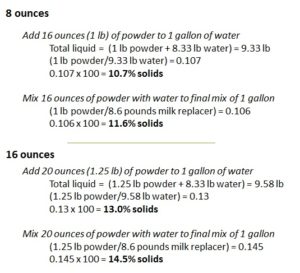
_________________________________
References:
* Abe, M, T. Iriki, K. Kondoh and H. Shibui. 1978. Effects of nipple or bucket feeding of milk-substitute on rumen by-pass and on rate of passage in calves. Br. J. Nutr. 41: 173
